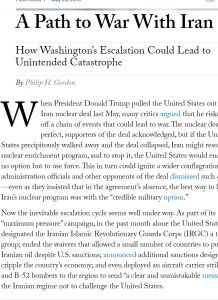Únase a getAbstract para acceder al resumen.

Únase a getAbstract para acceder al resumen.
Philip H. Gordon
A Path to War With Iran
How Washington’s Escalation Could Lead to Unintended Catastrophe
Foreign Affairs, 2019
¿De qué se trata?
Trump’s high-risk approach toward foreign adversaries may threaten the peace.
Recommendation
A few months after President Donald Trump’s inauguration, Philip H. Gordon, a former Obama official, warned in a published essay that Trump’s erratic and belligerent approach toward US adversaries could result in an unintended military catastrophe. Two years later, Gordon believes that his Cassandra cries have been partially vindicated, pointing to escalating tensions between the United States and Iran, China, North Korea and Venezuela. In a follow-up piece, Gordon explains how recent US foreign policy moves fit into the President’s pattern of high-risk deal-making – an approach he believes does not bode well for keeping the peace.
Summary
About the Author
Philip H. Gordon is a senior fellow at the US Council on Foreign Relations. He is a former Special Assistant to the President and served as White House Coordinator for the Middle East, North Africa, and the Gulf Region from 2013 to 2015.

















Comment on this summary